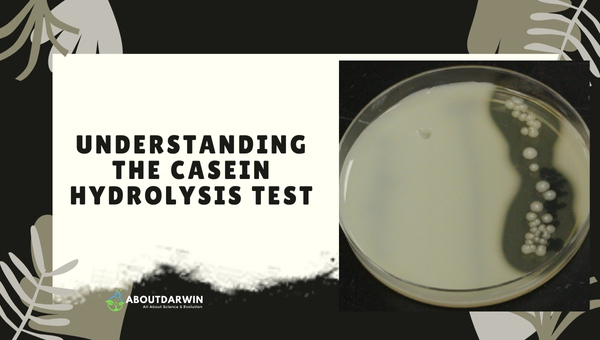Physical Address
304 North Cardinal St.
Dorchester Center, MA 02124
Exploring the fascinating intersection of microbiology and enzymatic processes, the casein hydrolysis test stands out as a vital tool for identifying bacteria that produce caseinase, an enzyme responsible for breaking down casein, the primary protein in milk.
This test not only showcases the intricate relationships between microorganisms and their substrates but also highlights the practical applications in various industries, from dairy to biotechnology.
As we delve into the mechanics of casein hydrolysis, we uncover how this seemingly simple process reveals profound insights into microbial behavior and its implications in health and industry.
Contents
Casein hydrolysis is a biochemical process where bacteria break down casein, the primary protein found in milk, using a specific enzyme called caseinase.

This enzymatic reaction allows microorganisms to transform complex milk proteins into smaller, more digestible amino acids and peptides, which can be used for metabolic processes.
Casein hydrolysis is a biochemical test used to determine a bacterium’s ability to synthesize the caseinase enzyme, which breaks down casein protein into smaller soluble units.
The test involves observing whether bacteria can produce an extracellular proteolytic enzyme capable of hydrolyzing milk proteins.
The casein hydrolysis test operates on a straightforward yet fascinating principle, much like a chef breaking down large ingredients into smaller, digestible pieces using a food processor.
Here, the enzyme caseinase plays the role of the processor, targeting casein protein found in milk or similar substrates.
In this test, bacterial colonies are cultured on an agar medium enriched with casein protein. Bacteria capable of producing caseinase enzymatically hydrolyze casein, breaking it down into smaller components such as amino acids and peptides.
The hallmark of this reaction is the formation of a clear zone around the bacterial colony on the otherwise opaque, milky agar plate. This clear zone signifies the breakdown of casein and serves as a visual indicator of the bacteria’s ability to produce the enzyme caseinase.
This simple yet effective casein test helps identify specific bacteria with casein-degrading capabilities.
Also Read: Unraveling Potato Dextrose Agar (PDA): Principle & More
The Casein Hydrolysis Test is a microbiological procedure used to determine a bacterium’s ability to produce caseinase enzyme, which breaks down casein protein.
The casein hydrolysis test involves several critical steps designed to identify bacteria capable of producing proteolytic enzymes:
Preparation Phase
Execution Phase
Result Interpretation
The test’s success depends on meticulous technique, much like preparing a precise culinary recipe, ensuring each step is executed with accuracy and care.
Also Read: Exploring Differences: Gram Positive vs Gram Negative Bacteria
The Casein Hydrolysis Test is a biochemical method used to determine a microorganism’s ability to produce the enzyme caseinase, which can break down casein protein.
Key Purposes of the Casein Hydrolysis Test:
Specific Applications:
The test works by inoculating bacteria on a skim milk agar plate. Bacteria that can produce caseinase will create a clear transparent zone around their growth, indicating successful protein hydrolysis. Bacteria unable to break down casein will show no clear zone, resulting in an opaque medium.
Important Considerations:
Also Read: All About Lightning: The Power of Nature’s Light Show
A casein hydrolysis test is a crucial microbiological technique that reveals a bacterium’s ability to break down casein protein, providing insights into its enzymatic capabilities and metabolic characteristics.
This test helps researchers and microbiologists identify and differentiate bacterial species based on their proteolytic activities.
The casein hydrolysis test results provide critical insights into bacterial enzymatic capabilities. By observing the formation of clear zones on milk agar plates, microbiologists can quickly determine whether an organism possesses the ability to break down complex milk proteins.
These results are essential for understanding bacterial metabolism, identifying specific microbial species, and assessing their potential industrial or clinical applications.
Positive casein hydrolysis organisms represent a diverse group of bacteria with unique protein-degrading capabilities. These microorganisms possess specialized enzymes that can effectively break down casein, demonstrating remarkable metabolic flexibility.
Their ability to hydrolyze proteins makes them significant in various fields, including food production, pharmaceutical research, and microbial ecology, where protein breakdown is a crucial biological process.
The casein hydrolysis market continues to expand, driven by increasing demand in food processing, biotechnology, and pharmaceutical industries.
Researchers and manufacturers are exploring innovative applications of casein hydrolysis, such as developing specialized protein supplements, creating hypoallergenic food products, and designing advanced enzymatic technologies.
This growing market reflects the significant potential of understanding and utilizing protein hydrolysis mechanisms.
The test’s ability to detect caseinase enzyme production makes it a valuable tool for microbiological classification and research.
Also Read: Isostatic Rebound: Uncovering Post-glacial Rebound Process
Precautions are mainly aimed at preventing contamination and ensuring personal safety. Proper sterilization of equipment, maintaining sterile working conditions, and adequate disposal of cultured plates are critical. Always remember to use protective gear!
Most commonly, visible results can take around 24-48 hours post-incubation at an optimal temperature. However, some slow-growing bacteria might show clearer zones even after several days.
The tests themselves don’t have side effects per se, but mishandling microbial cultures or exposure could result in accidents or contamination.
This test is essential as it helps identify specific kinds of bacteria that produce caseinase enzyme – an important aspect when diagnosing certain bacterial infections. It improves accuracy in diagnosing diseases by confirming specific enzyme production capabilities!
It appears that the casein hydrolysis test represents a critical microbiological technique for evaluating bacterial enzymatic capabilities.
By examining the ability of microorganisms to break down casein protein, researchers can effectively identify and differentiate bacterial species based on their proteolytic activities.
The test provides valuable insights into microbial metabolism, enzyme production, and potential pathogenic characteristics, ultimately contributing to our understanding of bacterial physiology and taxonomic classification.